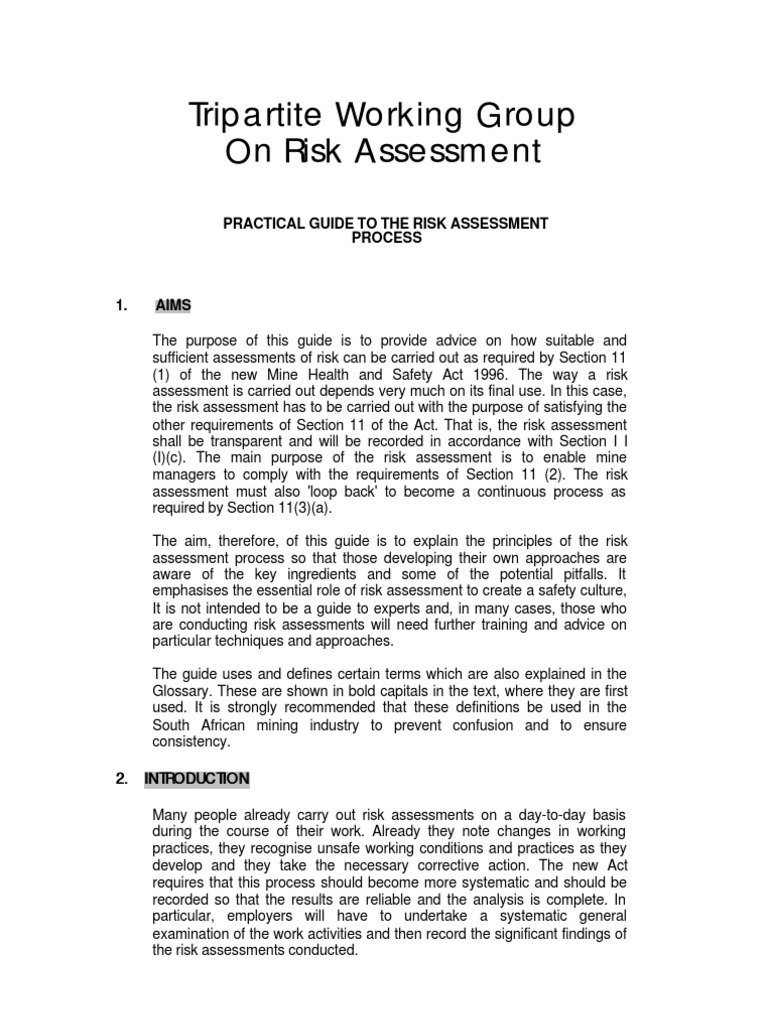Finding The Real Safe Bet: A Practical Guide To Risk Management

Table of Contents
Identifying Potential Risks
The first step in effective risk management is identifying potential threats. This involves clearly defining your objectives and then brainstorming potential issues that could prevent you from achieving them.
Defining Your Objectives
Clearly outlining your goals is paramount. What are you trying to achieve? Understanding your objectives will illuminate potential pitfalls. Vague goals leave you vulnerable to unforeseen risks. The more specific your goals, the better you can anticipate potential problems.
- Investing: Aiming for a 10% annual return on a specific investment portfolio within five years.
- Starting a Business: Achieving profitability within the first year of operation, with a specific target customer base.
- Launching a New Product: Reaching a market share of 5% within the first six months of launch.
Using the SMART goal framework is crucial:
- Specific: Clearly define what you want to achieve.
- Measurable: Set quantifiable targets to track progress.
- Achievable: Ensure your goals are realistic and attainable.
- Relevant: Align your goals with your overall strategy and resources.
- Time-bound: Set deadlines to create a sense of urgency.
Brainstorming Potential Threats
Employ techniques like SWOT analysis (Strengths, Weaknesses, Opportunities, Threats) and brainstorming sessions to uncover potential risks. Don't hesitate to consider even seemingly improbable scenarios. A thorough risk assessment is crucial.
- Financial Risks: Insufficient funding, fluctuating exchange rates, unexpected expenses.
- Operational Risks: Supply chain disruptions, equipment malfunctions, employee turnover.
- Strategic Risks: Changes in market demand, competitor actions, regulatory changes.
- Reputational Risks: Negative publicity, product recalls, ethical breaches.
Utilizing a risk register—a centralized document listing identified risks, their potential impact, and mitigation strategies—is highly beneficial for systematic risk identification and tracking.
Assessing Risk Probability and Impact
Once risks are identified, you need to assess their probability and potential impact. This allows you to prioritize risks and allocate resources effectively.
Quantifying the Likelihood
Assign probabilities to each identified risk, ranging from low to high. A simple 1-5 scale (1 = very unlikely, 5 = very likely) can be effective. Consider historical data, expert opinions, or simulations to inform your assessment.
- Historical Data: Analyze past performance to predict the likelihood of similar events.
- Expert Opinion: Consult with individuals with relevant experience and expertise.
- Simulations: Use models and simulations to assess the likelihood of different outcomes.
Evaluating the Severity of Impact
Determine the potential consequences if a risk materializes. Consider both qualitative and quantitative impacts.
- Financial Loss: Estimate potential monetary losses in dollars.
- Impact on Project Timeline: Assess potential delays and their consequences.
- Reputational Damage: Evaluate the potential impact on brand image and customer trust.
A risk matrix, which visually represents the probability and impact of various risks, is a powerful tool for prioritizing risks. High-probability, high-impact risks demand immediate attention.
Developing Risk Mitigation Strategies
After assessing risks, develop strategies to address them. Several approaches exist:
Risk Avoidance
Eliminate the risk entirely by altering plans or avoiding certain activities.
- Example: Choosing a less risky investment instead of a high-risk, high-return option.
- Example: Canceling a project with significant uncertainties and potential for substantial losses.
Risk Reduction
Implement measures to decrease the probability or impact of a risk.
- Example: Diversifying investments to reduce the impact of poor performance in a single asset.
- Example: Purchasing insurance to transfer the financial burden of potential losses.
- Example: Implementing robust safety procedures to reduce the likelihood of workplace accidents.
Risk Transfer
Shift the risk to a third party, often through insurance or outsourcing.
- Example: Purchasing liability insurance to protect against lawsuits.
- Example: Outsourcing a high-risk task to a specialized company with expertise in managing that risk.
Risk Acceptance
Accept the risk and its potential consequences, usually when the cost of mitigation outweighs the potential loss.
- Example: Accepting a small chance of project delays due to unforeseen circumstances.
- Example: Accepting minor market fluctuations as a normal part of investing.
Monitoring and Reviewing Risk
Risk management isn't a one-time event; it's an ongoing process.
Regular Monitoring
Regularly review identified risks and their status. Are new risks emerging? Are existing mitigation strategies still effective?
- Frequency: Monthly or quarterly reviews are often sufficient, depending on the nature and severity of the risks.
- Key Risk Indicators (KRIs): Use dashboards to monitor key risk indicators and identify early warning signs of potential problems.
Adapting to Change
Be prepared to adapt your strategies as circumstances change.
- Flexibility: Risk management requires flexibility and the ability to respond to unforeseen events.
- Responsiveness: Regularly update your risk assessment and mitigation strategies based on new information and changing circumstances.
Conclusion
Finding the "real safe bet" isn't about eliminating all risk—it's about understanding, assessing, and managing it effectively. By systematically identifying potential threats, evaluating their likelihood and impact, and developing appropriate mitigation strategies, you can significantly reduce your exposure to unwanted outcomes. Proactive risk management is key to achieving your goals while minimizing potential losses. Start implementing these risk management strategies today and discover the confidence that comes from making informed decisions. Learn more about securing your future with effective risk management and discover how to make better, safer bets.

Featured Posts
-
 Implications Of Trumps Announced Trade Agreement With The Uk
May 09, 2025
Implications Of Trumps Announced Trade Agreement With The Uk
May 09, 2025 -
 Inquiry Into Nottingham Attacks Retired Judge Takes The Lead
May 09, 2025
Inquiry Into Nottingham Attacks Retired Judge Takes The Lead
May 09, 2025 -
 Britannian Kruununperimysjaerjestys Uusin Versio Ja Selitys
May 09, 2025
Britannian Kruununperimysjaerjestys Uusin Versio Ja Selitys
May 09, 2025 -
 Harry Styles Reacts To A Hilariously Bad Snl Impression
May 09, 2025
Harry Styles Reacts To A Hilariously Bad Snl Impression
May 09, 2025 -
 10 Ahli Dewan Undangan Negeri Pas Selangor Bantu Mangsa Tragedi Putra Heights
May 09, 2025
10 Ahli Dewan Undangan Negeri Pas Selangor Bantu Mangsa Tragedi Putra Heights
May 09, 2025
